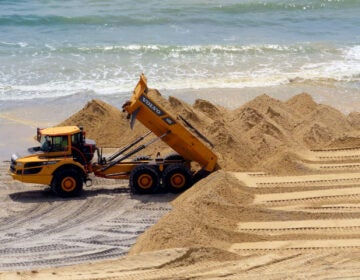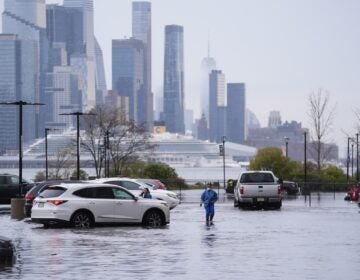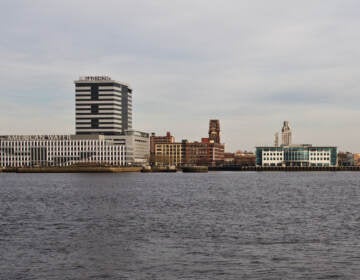Why the Red Knot bird lives and dies by what happens here
-
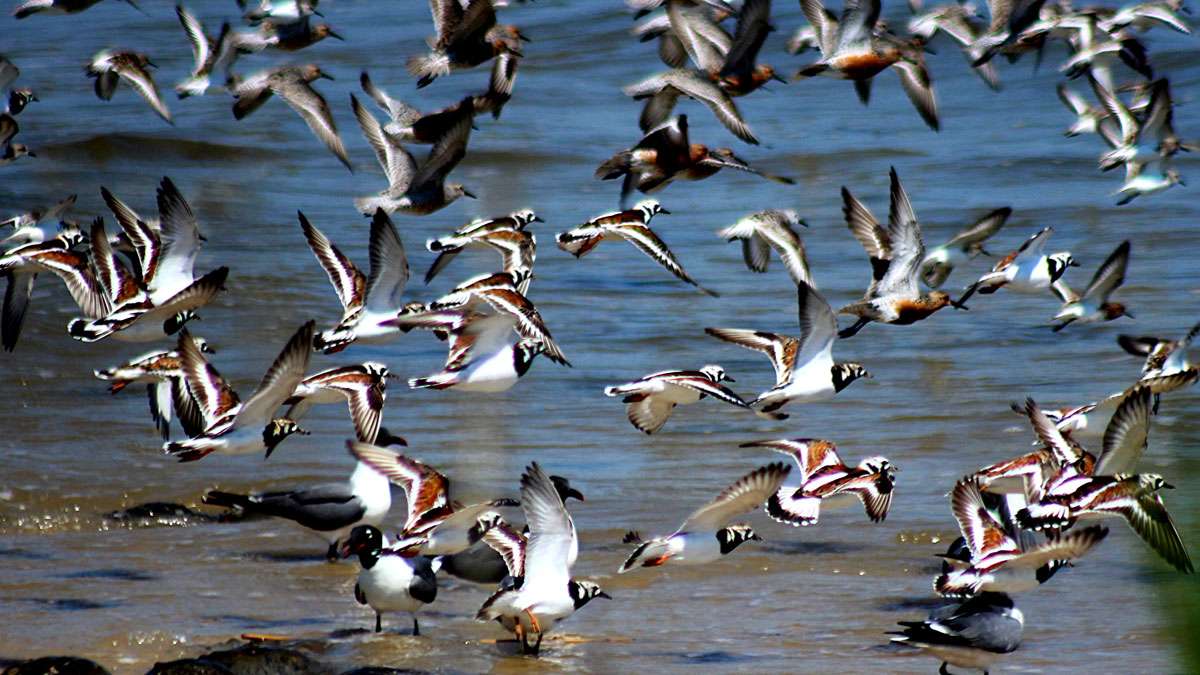
Shorebirds take flight along the Delware Bay in Cape May County, New Jersey. (Bill Barlow for WHYY, file)
-
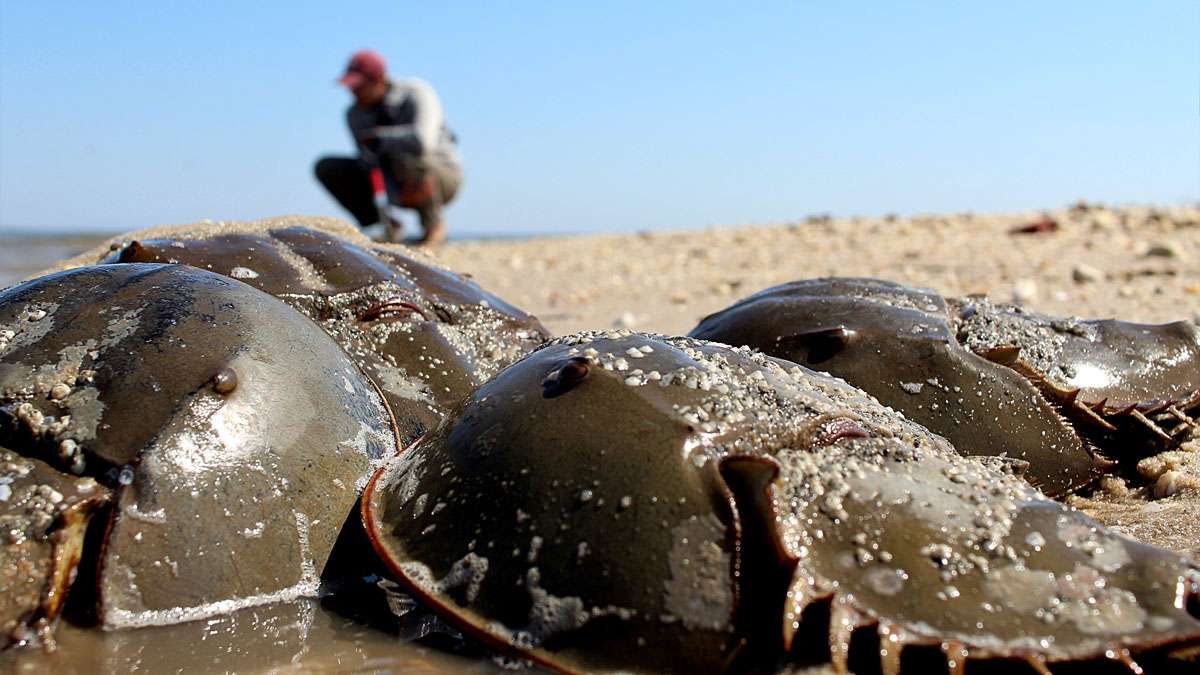
Horseshoe crabs lay eggs that the Red Knot rely on. (Bill Barlow/for WHYY)
-
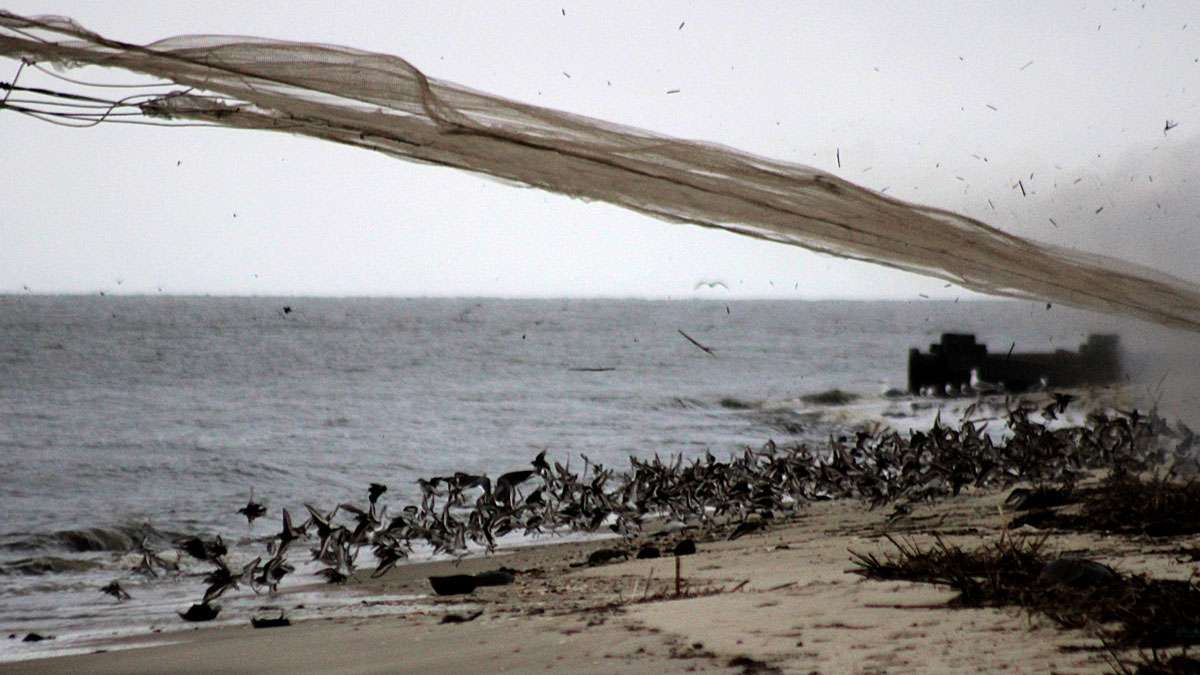
The moment the net is fired over the birds on the beach. (Bill Barlow/for WHYY)
-
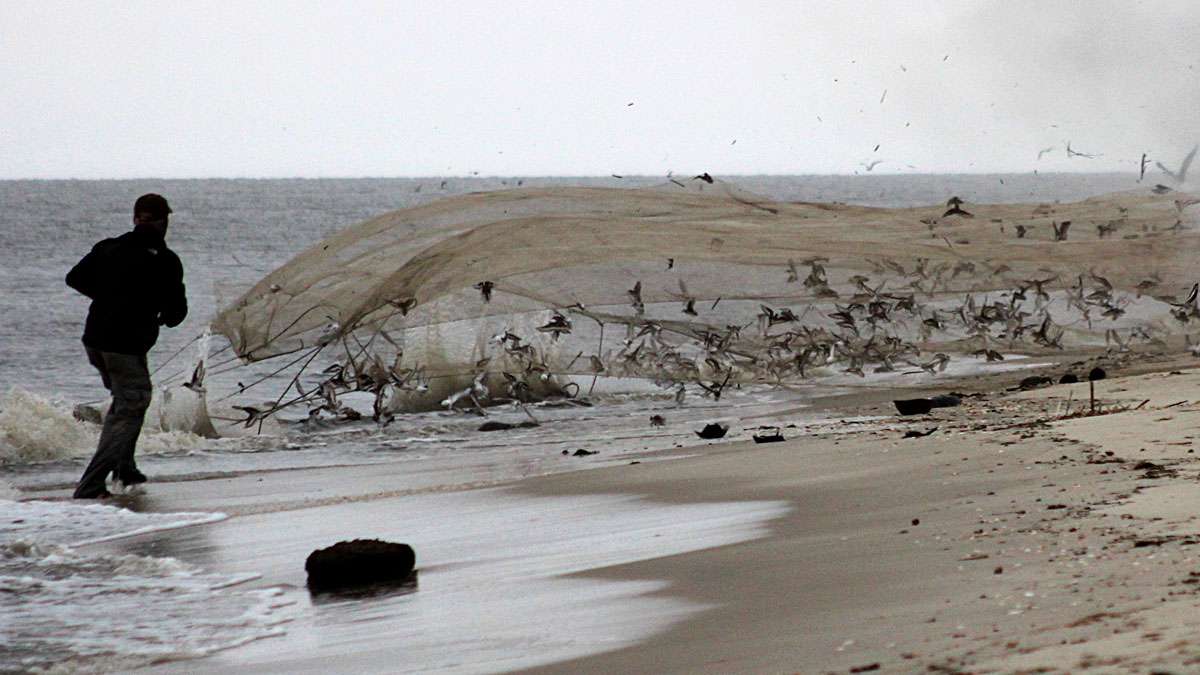
The net lands on the birds. The Red Knots will be tagged and released. (Bill Barlow/for WHYY)
-
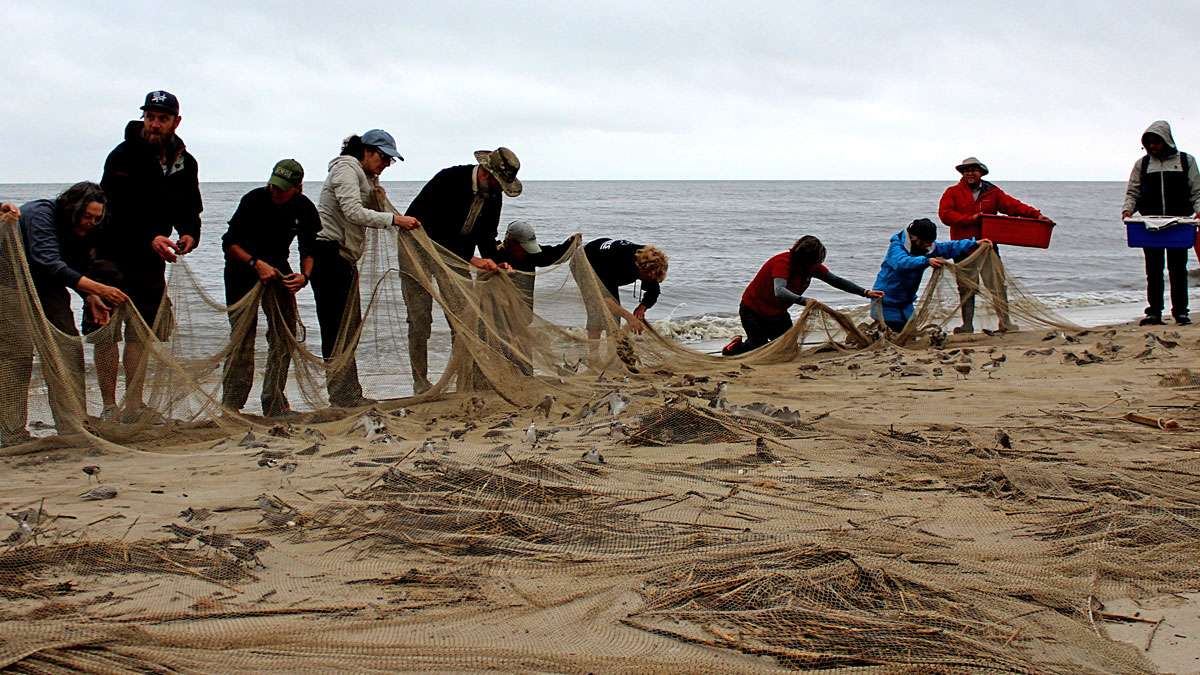
Volunteers now have to identify and tag and the Red Knots. (Bill Barlow/for WHYY)
-
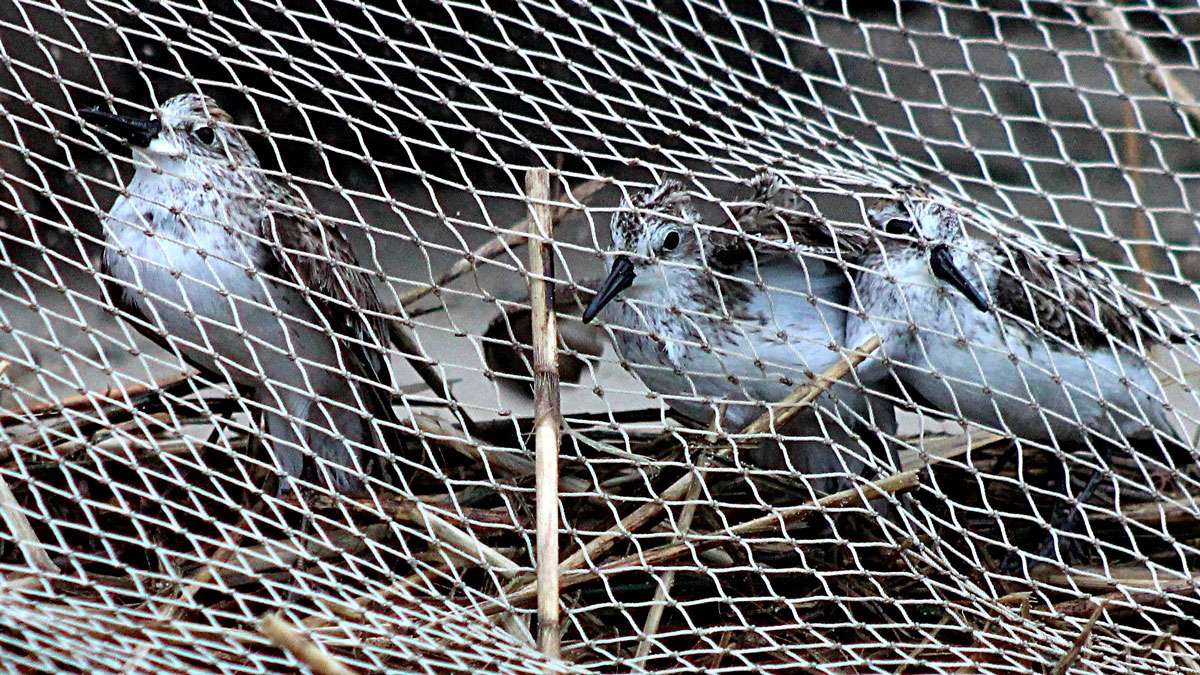
Birds under the net before they are tagged and released. (Bill Barlow/for WHYY)
Everything is in place along the Delaware Bay beach on an early late Spring morning. The net is carefully folded, the cannons set at the correct angle, the charges set and slowly, the birds return to the beach, while Larry Niles watches with powerful binoculars. Beside him, Dick Veitch has his hand on the detonator.
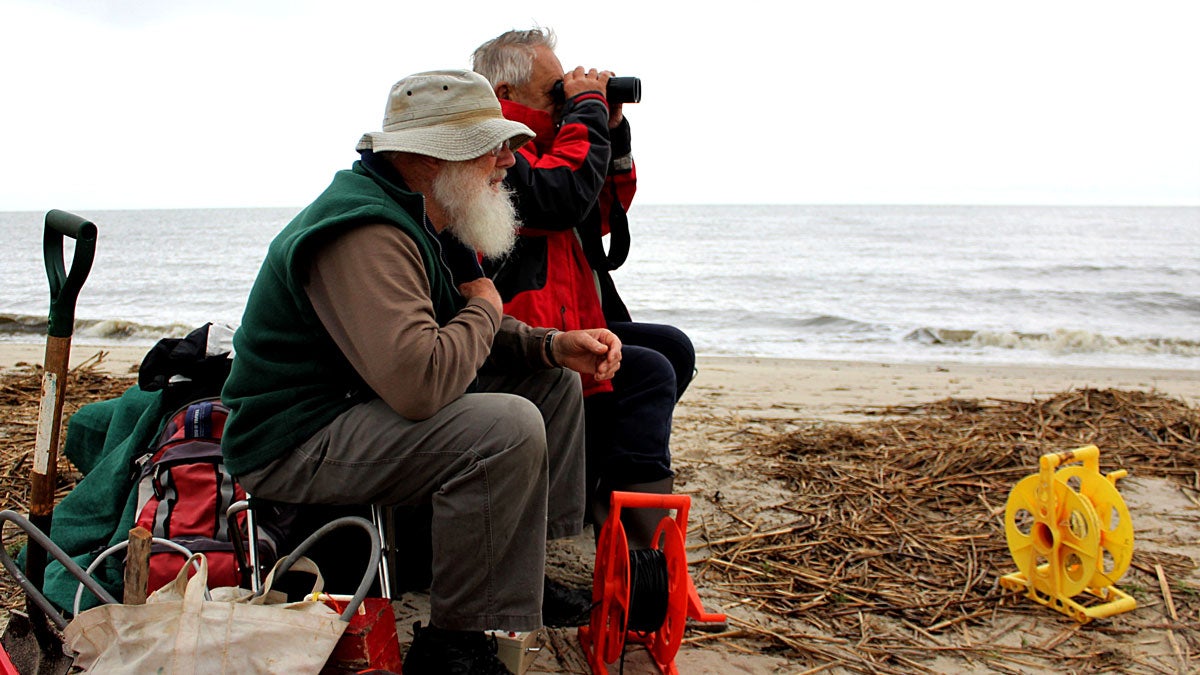
But there aren’t quite enough birds yet. Niles, a biologist working with the Conserve Wildlife Foundation, is worried. He’s getting ready to fire a net over about 100 shorebirds, using gunpowder charges, while a group of Rutgers students and a camera toting reporter sit on the dunes about 1,000 feet away.
He’s on the radio talking to a spotter on the far side of the net, trying to make sure there are as many birds as possible in the catch zone, while minimizing the possibility of any of the birds getting hurt. In a wider sense, he’s worried about funding for environmental organizations in a year when President Trump’s budget proposal eliminates funding for a number of programs, including some that help protect the Delaware Bay. He’s worried about the long-term impact of climate change on the bay, and on the wildlife that depend on it. But mostly, he’s worried about the birds getting enough to eat. This year, it seems there may not be enough available.
Every year, thousands of shorebirds stop along the Delaware Bay during their long migration. Exceptionally cool water this year, and a combination of other factors, means there are fewer birds in the bay, and fewer crabs spawning. That in turn means the birds that are here have not gained the weight they need. “We don’t have enough crabs,” he said.
Global migration gets locals Joining Niles on the beach is an international team of ornithologists who have studied a migrating shore bird called the red knot for decades. One of the numerous shorebirds that visits the beaches of the Delaware Bay each spring, the red knot has an incredible migration, with some individuals traveling from Tierra Del Fuego in South America to their breeding ground in the artic.
Pit stop
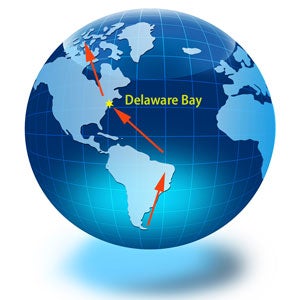 Along the way, the birds stop along the Delaware Bay to fatten up on the eggs of the horseshoe crabs that spawn in late spring, depending on the fatty crab caviar to regain some of the body fat they lost on the flight of thousands of miles and to pick up enough calories to carry them the rest of the way.
Along the way, the birds stop along the Delaware Bay to fatten up on the eggs of the horseshoe crabs that spawn in late spring, depending on the fatty crab caviar to regain some of the body fat they lost on the flight of thousands of miles and to pick up enough calories to carry them the rest of the way.
As Clive Minton explains to the Rutgers students gathered before him while Niles and others get the net prepared, the birds lose a huge amount of weight on the journey from South America to the Delaware Bay. He compared it to a 747 traveling across the country, using about a third of the total weight of the plane as it burns off fuel. The birds need to refuel before taking off again. That means building up some 60 percent of their body weight.
One reason we know so much about the migration pattern is the work of a group of dedicated amateur ornithologists like Minton. As a boy in northern England, he loved birds, he said, and after he moved to Melbourne, Australia, he began studying the migration of the red knot, following the birds for thousands of miles.
About 20 years ago, that journey took him and the rest of the team to the Delaware Bay, a prime stopover for the migrating birds, including red knots, sandpipers, sanderlings, ruddy turnstones and others. “When we got here, we found that what had been a scientific journey became a mammoth conservation issue,” he said.
Horseshoe crabs
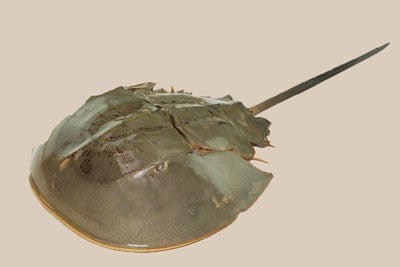 Horseshoe crabs had never been a species of particular concern. They’ve remained more or less unchanged since the time of the dinosaurs, and are not caught for food. But they can be used as bait for other food species, including whelk, and with no regulations in place, some locals were loading the backs of pickups with the larger female crabs, just as they arrived on the beaches to breed. “That’s not what you do in any country with any animal, anywhere, and here it’s happening in America,” said Minton.
Horseshoe crabs had never been a species of particular concern. They’ve remained more or less unchanged since the time of the dinosaurs, and are not caught for food. But they can be used as bait for other food species, including whelk, and with no regulations in place, some locals were loading the backs of pickups with the larger female crabs, just as they arrived on the beaches to breed. “That’s not what you do in any country with any animal, anywhere, and here it’s happening in America,” said Minton.
His team, and local biologists, pushed to regulate the crab harvest, a deeply unpopular move among some commercial fishermen. Even at $1 or so a crab, Minton estimates some collected $2,000 worth of breeding crabs in a day, enough to impact the population in the bay, and in turn threatened the red knot, which is a protected species. In a recent blog post, Niles praised the work Minton and others like him have done for decades on behalf of the birds, and for the ecosystem as a whole.
Although it was never Minton’s career, his expertise and experience belies calling him an “amateur” when it comes to shorebirds. In the US, Niles wrote, much of the conservation work is done by paid staff. “It’s an entirely credible position in times of flush budgets. Its pitfall becomes obvious in the age of Trump, years of budget cuts and increasing influence of resource industries dismantle that achieved in the good years,” he wrote.
“Overall it ends with natural resources declining in nearly every section of the country.”The Delaware Bay Shorebird Project is a team effort between the Conserve Wildlife Foundation and the New Jersey Department of Environmental Protection’s endangered and nongame species program, along with the international team. The project has followed the birds from the length of the hemisphere, and has worked on understanding the Delaware Bay’s part in the puzzle for decades.
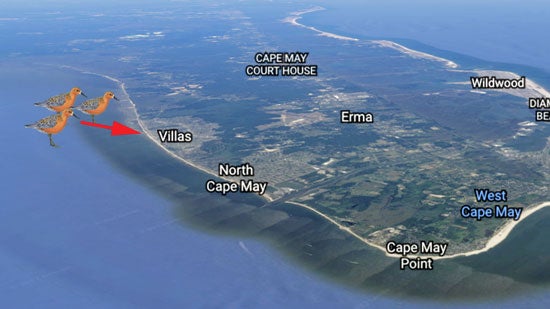
This spring is Minton’s 21st trip to the bay, and he’s joined by about 30 naturalists from England, Australia, New Zealand, Canada and elsewhere. “It’s a very international team,” he said. At one time, they would share a house, but now they get several houses in Reeds Beach, a section of Middle Township in Cape May County on the bay. Every night, a group of volunteers prepare food, which he said is welcome after they’ve been working in the field for 14 and a half hours.
“You’re just too bloody tired after you get done to make dinner,” he said. Casserole for 30 is just one of the ways a network of supporters help keep the work going. “That is fantastic support.” Veitch comes from New Zealand, while Humphrey Sitters comes from the United Kingdom.
Barrie and Angela Watts have been coming from Canada for 17 years. John and Linda Turner also made the long drive from Canada the day before, heading south from a First Nation community to witness the study.
Susan Taylor got involved in Victoria, Australia and now heads to the Delaware Bay each year, helping sort, weigh and release the captured birds. Before she came, she had never heard of the Delaware Bay. She described the spot as beautiful, one of a number of beautiful places she’s seen in New Jersey since first visiting. “There are just so many gems,” she said.
About the birds Niles is on the walkie-talkie, getting ready to give the signal to blow the charges that will send the net over the birds. Minton says his heart rate is rising, which apparently happens with every netting. The sporadic flurry of birds flying off from the capture area is not helping. The charges will fire heavy cylinders across the beach and into the bay, which are attached to the wide net that will be carried across the beach and over the birds. Niles wants to go when a wave is heading in, concentrating the birds.
A short 3-2-1 countdown, and with a bang the net is off, and the students are charging up the beach, hurrying to pull any birds from the water and to keep them from hurting themselves. A tarp is pulled over to calm the birds, while the volunteers sort through them. The semi-palmated plover are released immediately, while the sanderlings are placed in boxes to be weighed, measured and tagged. There are ruddy turnstones, a larger bird, to be seen near the waterline, but none of those are in the net, and no red knots at all in that area that morning.
The international team each walks a group of students through the tagging process. Sitters talks about the two tags each bird will receive, including one with a number that can be read through binoculars, allowing birders to track the migration the length of the hemisphere. He and Minton were among the team that came to the bay in 1997.
Like Niles, he’s also worried this year. There are indications that some of the birds have moved on in search of food. One bird that had been tagged a few days earlier was spotted the day before in Cape Cod. “That bird voted with its wings,” he said. New Jersey’s horseshoe crab restrictions came after a sharp decline in the red knot population, Sitters said.
Twenty years ago, the red knot population was around 50,000 to 60,000, down from about 100,000, That decline continued, with 30,000 counted in 2002, and 15,000 in 2003. There was finally a bit of a turnaround, with populations beginning to bounce back. Now, with few eggs available, he’s concerned about another crash. Timing is (almost) everything A few days earlier, on a brilliant morning, Joe Smith walks slowly along the edge of a deserted stretch of bay beaches, trying not to flush the teaming mass of shorebirds darting back and forth with the waves.
Unlike the beaches in Villas, there are no houses overlooking this beach, at the corner of Cumberland County near the mouth of the Maurice River. Here, too, there are not nearly as many crabs as Smith usually sees this time of year. A biologist who works with Niles, Smith is set to count crab eggs to look at the potential impact of aquaculture on the crab populations. But at the site, he doesn’t find enough crabs to count.
There was once a tiny community here, called Thompson’s Beach, destroyed and deserted in 1950 after an extraordinary high tide washed through. Several other, similarly remote communities remain along the bay beaches in Cumberland and Cape May counties. After a long, crawling drive along a dirt road through sprawling marsh leading out to the bay, you might think you were now in untrammeled nature. You’d be wrong. The marshland had been created by PSE&G as part of a mitigation project, aimed at building habitat and increasing fish populations in the bay, Smith explains, and the beach itself was built under an Army Corps of Engineers contract, like so many of the ocean beaches on the other side of the Jersey cape. But in this case, the project aimed at restoring habitat for the horseshoe crabs and the migrating birds that depend on them.
These projects help protect endangered species, but are also important to protecting remote bayshore communities and for economic development, according to Tim Dillingham, the executive director of the American Littoral Society. Reached by phone after the bay visit, he said these and other habitat restoration projects are cost effective, and they work. “This is the way conservation efforts are supposed to work,” he said, combining local, private and public resources. Working with the U.S. Fish and Wildlife Service and others, he said, the American Littoral Society has secured $4.7 million over the past several years for similar projects. But they are also in the crosshairs.
The budget proposal put forth by Presidents Trump’s administration cuts or eliminates spending on a number of programs that enforce environmental regulations or protect species. He said the administration’s budget includes significant cuts to numerous environmental protection programs.
Dillingham said he had spoken with some in Congress who said they, not the White House, control federal spending. But he added that it is a much more difficult fight to restore funding that has been zeroed out, and the Republican-controlled Congress includes many who are actively hostile toward conservation efforts. Restoring 50 percent of the funding for some projects could seem like a victory, but it will still mean a huge cut in funding.
Back at the bay, an immature bald eagle glides over the scene, startling the other birds. The flocks make a racket, but there are no other sounds, and the only footprints on the beach are from birds, crabs, turtles and what may have been an otter.
Among the teaming mass of birds are ruddy turnstones, sanderlings, and a few groups of red knots, along with several laughing gulls, all scrambling for a meal of crab eggs. Smith takes a detour, to the mouth of a tiny inlet, where the warmer water has drawn a few crabs at high tide. Males swarm the larger females, who bury tiny eggs in the damp sand. Here there are crabs in large numbers, but elsewhere along the beach, there are only a few individuals. Some years, crabs bury the beach.
Once, starting in the 19th century, tons of crabs were pulled from beaches, ground up and used for fertilizer. That harvest eventually stopped, and in the middle of the 20th century, there was a boom in the horseshoe crab numbers, according to a history posted at horseshoecrab.org. Later, the commercial harvest for the crabs to use as bait began to again impact the species, which is where Minton, Sitters and the crew arrive on the scene in the 1990s.
While the commercial crab catch has been curtailed in New Jersey, the crabs are still collected for their blue blood, which has some extraordinary properties, making it immensely useful in medical research. Unfortunately, according to Smith, there is very little oversight of the crab collection for research. The crabs are returned to the water after the blood is taken, but he said it is difficult to know how many of those crabs survive after release, or what impact that may have on the crab’s later breeding.
What next?
Back at the beach in Villas, the students carefully tag the collected sanderlings. Niles said if the birds don’t gain enough weight, it’s less likely for them to make it north to breed, or to survive the trip back. He said the birds face an unyielding deadline:
They must leave the Delaware Bay in early June to nest in the middle of the month, for the offspring to have a chance to hatch and fledge in time for the long return journey.There are two bird populations, one that makes the long trip from south America, and another that spends the winter a little closer to home, he said. It’s the birds that travel farthest that are in most need of the fatty boost of crab eggs. The birds can live on invertebrates gathered at the waterline, but it will take far longer and a lot more energy to crack those tiny shells and eat enough to gain the needed weight back, and as he said, the clock is ticking. While water temperatures are part of the issue depressing crab populations,
Niles is concerned about the impact of the continued crab harvest, and the possible effects of a budding aquaculture industry on the bay. He said occasional lean years and fluctuating temperatures are inevitable, but that’s part of the reason a thriving crab population is so important, so that eggs will be plentiful even in a cooler spring. Minton and the others have followed the birds from Tierra Del Fuego to the artic, and for two decades have returned to the Delaware Bay every spring, delving ever deeper into the vast mechanism that moves these birds around the hemisphere.
Humphrey Sitters began his journey in 1967, joining an international expedition to study red knot migration.While he speaks to a new generation of naturalists, a pod of dolphin passes a few hundred feet out in the bay. He had hoped to see a steady increase in the populations of migrating birds year after year, but it looks like the path to recovery may not be perfectly smooth.
WHYY is your source for fact-based, in-depth journalism and information. As a nonprofit organization, we rely on financial support from readers like you. Please give today.


